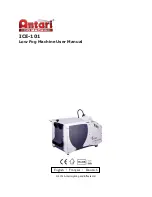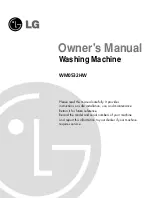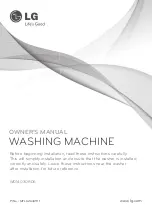
SAFETY PRECAUTIONS
WARNING
READ AND UNDERSTAND THESE SAFETY PRECAUTIONS BEFORE OPERATING
MACHINE. FAILURE TO PROPERLY FOLLOW THESE PRECAUTIONS MAY LEAD TO A
FIRE, EXPLOSION, OR ELECTRICAL SHOCK HAZARD.
1.
Electric Power
.
This machine uses electrical power at common commercially available
voltages. When directly contacted, such voltages are hazardous to human life. All precautions
commonly applicable to the use of the electric power general are applicable to the use of this
machine. This machine is designed to operate from three wire power systems where one of the
wires is a safety ground. Do not disconnect the safety ground or use extension cords or
“cheater” plugs to connect this machine to a two-wire system. This defeats the purpose of the
safety ground and may result in a hazardous electrical shock condition.
When making adjustments on the machine, use an area or workbench that is dry and not
electrically conductive. Dry, natural wood and plastics are generally non-conductive at the
working voltages of this machine. Metals are usually conductive. Do not probe inside the
machine.
Extension cords must be properly sized and rated for the voltage, current, and LENGTH of an
individual cord. Consult the nameplate current and voltage rating of your machine and the
marked rating of the extension cord. A single extension cord only should be used. When two or
more extension cords are placed in series, the rated current carrying capacities of the cords may
no longer be valid. If an extension cord gets warm to the touch, discontinue its use and obtain a
cord with a higher current rating. Improper extension cords are not only hazardous, but may
result in poor machine performance due to excessive voltage drop. Finally, since the machine
uses oil-based formulations, the extension cord should be rated as oil resistant.
2.
Formulations
.
Many formulations are combustible; that is, they all can be caused to burn.
This is true of even high flash point or “no” flash point formulations (fine particle dust in a grain
mill has “no” flash point). A combustible liquid vapor can more easily be ignited because it more
readily forms a uniform mixture with the air, which contains the oxygen needed for combustion.
However, fine particles of combustible liquids or solids suspended in the air very closely spaced
are capable of propagating flame from one to another once ignition starts. A good analogy is the
grain mill explosion. Although the fine particle dust in a grain mill has “no” flash point, the
phenomena of the grain mill explosion is an all too common occurrence.
While a high flash point
or a “no” flash point liquid formulation will ignite far less readily than a low flash point liquid; and
for this reason is strongly advocated, the high or “no” flash point formulation can ignite if the
proper conditions exist. These conditions are basically two: 1. a sufficient volume of liquid in the
form of fine particles suspended in the air; and 2. a sufficiently high energy source of ignition.
3.
Aerosol Concentration
.
It has been fully established that an acceptable level of liquid in the
atmosphere is one gallon per 50,000 cubic feet (2.7 liters per 1,000 cubic meters). There is a
safety margin of at least 5 to 1 in this figure.
4.
Aerosol Ignition
.
If a combustible atmosphere is established or a combustible deposit is laid
down, a source of ignition may cause a fire. Sources of ignition can be gas or oil pilot lights or
sparks from electrical controls. Therefore, it is strongly recommended that all such sources be
eliminated by extinguishing all pilot lights and turning off all unnecessary electric power. To avoid
Curtis Dyna-Fog, Ltd. 2008
4


































